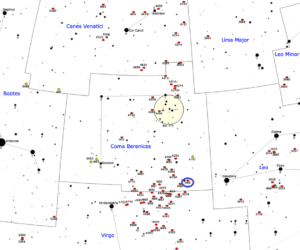Messier 98 is an intermediate spiral galaxy located in the Virgo Cluster, in the constellation Coma Berenices. The galaxy is inclined at a 74-degree angle to our line of sight and appears almost edge-on. It is one of the faintest objects in the Messier Catalogue and, having a low surface brightness, one of the most difficult Messier objects to observe.
The light of the nucleus is obscured by a large amount of dust in the galaxy’s disturbed, elongated disk, which also contains numerous star forming regions. The dust was produced during tidal collisions and interactions with neighbouring galaxies.
| Description | |
| Visible From Pacific Northwest | January to May |
| Best Time To Observe | May |
| Minimum Size Of Viewing Device | Small Telescope |
| Object Type | Intermediate Spiral Galaxy |
| Designations | Messier 98, M98, NGC 4192, PGC 39028, ALFALFA 1-177, UGC 7231, VCC 92, Z 98-108, Z 1211.2+1510, INTREF 480, IRAS 12112+1510, 2MASX J12134829+1454016, MCG+03-31-079, NVSS B121115+151032, UZC J121348.2+145400 |
| Right Ascension | 12h 13m 48.292s |
| Declination | +14°54’01.69” |
| Constellation | Coma Berenices |
| Number Of Stars | 1 trillion |
| Apparent magnitude | +11.0 |
| Apparent dimensions | 9′.8 x 2′.8 |
| Object Radius | 80,000 light years |
| Distance From Earth | 44.4 Million Light Years |
History
Messier 98 was discovered by the French astronomer Pierre Méchain on March 15, 1781, along with the unbarred spiral Messier 99 and the grand design spiral galaxy Messier 100. Both these galaxies are located in the same region of the sky. Charles Messier determined the position for the object and added it to his catalogue on April 13, 1781, after completing the third edition. He offered the following description of M98:
Nebula without star, of an extremely faint light, above the northern wing of Virgo, on the parallel & near to the star no. 6, fifth magnitude, of Coma Berenices, according to Flamsteed. M. Méchain saw it on Mar 15, 1781.
Charles Messier
John Herschel catalogued M98 as h 1132 and later included it in his General Catalogue as GC 2786. He described the object as “bright; very large; very much extended in position angle 152.1 degrees; very suddenly very much brighter toward the middle.”
Locating M98 In The Sky
Messier 98 can be found about 6 degrees east of the bright star Denebola in the constellation Leo and only 0.5 degrees west of the 5th magnitude star 6 Comae Berenices. The galaxies Messier 99 and Messier 100, located in the vicinity of M98, are both brighter and easier to see. The best time of year to observe the galaxies is during the spring.

Viewing M98
M98 requires exceptionally clear, dark skies and at least a 4-inch telescope. 8-inch telescopes reveal a thin, hazy streak of light with a slightly brighter centre, while larger amateur telescopes show the nucleus more clearly.
Photographing M98
Imaging Messier 98 will require a larger telescope, accurate guiding, clear skies, and enough data collected. Small telescopes might have a tough time collecting all of the necessary data, as a 10 or 12 inch telescope is required. Messier 98 is maybe not as popular as the other targets in the Messier catalogue, but if one has a large scope and the patience, the image will be spectacular.
Sources And Further Reading
Descriptions of all of Messier Objects can be found here.
https://www.nasa.gov/feature/goddard/2018/messier-98
https://www.messier.seds.org/m/m098.html
http://www.astrophoton.com/M098.htm
https://www.cloudynights.com/topic/374303-finally-nailed-messier-91-98/

Be the first to comment on "Messier 98"